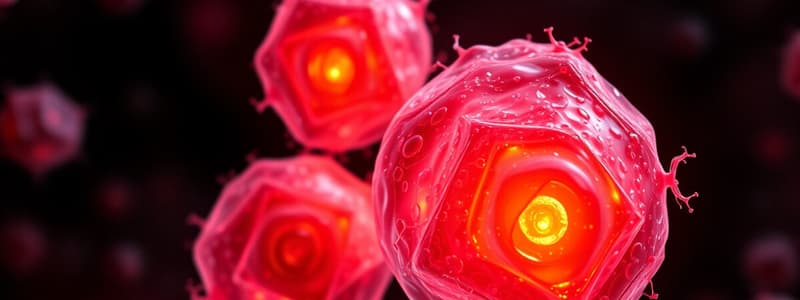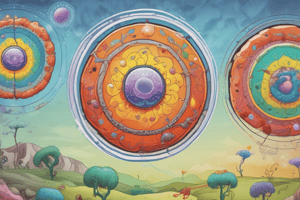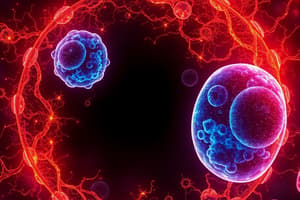Podcast
Questions and Answers
What is the primary outcome of mitosis?
What is the primary outcome of mitosis?
- Production of four non-identical daughter cells
- Formation of two genetically different daughter cells
- Equal division of the nucleus and cytoplasm into two identical daughter cells (correct)
- Replication of the cell's DNA without division
During which phase of mitosis do the chromosomes maximize their condensation and align at the equatorial plate?
During which phase of mitosis do the chromosomes maximize their condensation and align at the equatorial plate?
- Prophase
- Anaphase
- Telophase
- Metaphase (correct)
What is the role of spindle fibers during mitosis?
What is the role of spindle fibers during mitosis?
- They bind to the kinetochore to facilitate chromatid movement (correct)
- They assist in the formation of the nuclear envelope
- They condense the chromatin into chromosomes
- They replicate DNA to ensure genetic material is conserved
What is the primary event that occurs during anaphase?
What is the primary event that occurs during anaphase?
What structural components migrate to opposite poles during prophase of mitosis?
What structural components migrate to opposite poles during prophase of mitosis?
What occurs if centrioles are absent during mitosis?
What occurs if centrioles are absent during mitosis?
During telophase, which of the following events occurs?
During telophase, which of the following events occurs?
What role do the actin and myosin filaments play during cytokinesis?
What role do the actin and myosin filaments play during cytokinesis?
Which characteristic below describes the daughter cells at the end of mitosis?
Which characteristic below describes the daughter cells at the end of mitosis?
Which substance is known to disrupt the mitotic spindle and arrest cells in mitosis?
Which substance is known to disrupt the mitotic spindle and arrest cells in mitosis?
Flashcards
Mitosis
Mitosis
Cell division resulting in two identical daughter cells
Prophase (Mitosis)
Prophase (Mitosis)
Chromosomes condense, nucleolus disappears, centrosomes move to opposite poles, and spindle fibers form
Metaphase (Mitosis)
Metaphase (Mitosis)
Chromosomes align at the cell's equator; spindle fibers attach to kinetochores
Karyokinesis
Karyokinesis
Signup and view all the flashcards
Spindle fibers
Spindle fibers
Signup and view all the flashcards
Anaphase
Anaphase
Signup and view all the flashcards
Cytokinesis
Cytokinesis
Signup and view all the flashcards
Telophase
Telophase
Signup and view all the flashcards
Mitotic Spindle
Mitotic Spindle
Signup and view all the flashcards
Cleavage furrow
Cleavage furrow
Signup and view all the flashcards
Study Notes
Cell Cycle Control & Mitosis
- Learning Objectives: Students will understand the significance of different cell cycle phases and correlate them with normal and abnormal cell division outcomes.
Cell Cycle Control
- Cell cycle progression is regulated by cyclins and cyclin-dependent kinases (CDKs).
- Cyclin D binds to CDK4 and CDK6 in early G1.
- Cyclin E binds to CDK2 in late G1, allowing entry into S phase.
- Cyclin A binds to CDK2 and CDK1 to facilitate progression from S to G2.
- Cyclin B binds to CDK1 to allow entry from G2 to M phase.
Cell Cycle Checkpoints
- Checkpoints ensure proper DNA replication, growth, and chromosome segregation before allowing cell cycle progression.
- Factors stimulating cell cycle entry may include mechanical force, tissue injury, and cell death.
- These factors often involve the release of growth factors, influencing the activity of proto-oncogenes, which regulate cell proliferation.
Clinical Significance (Oncogenes & Cancer)
- Proto-oncogenes regulate normal cell proliferation.
- Mutations in these genes can lead to uncontrolled cell growth, forming oncogenes and contributing to cancer development.
- Oncogene alterations can involve DNA mutations, gene amplification, or rearrangements.
Chromosomes
- Chromosomes are highly condensed chromatin fibers visible during mitosis and meiosis.
- Each chromosome consists of two sister chromatids joined at the centromere.
- Chromosomes contain DNA, packaged with proteins (histones).
Mitosis
-
Mitosis is cell division resulting in two identical daughter cells.
-
Stages of mitosis:
- Prophase: Chromosomes condense, nucleolus disappears, centrosomes move to opposite poles.
- Metaphase: Chromosomes align at the cell's equator.
- Anaphase: Sister chromatids separate and move towards opposite poles.
- Telophase: Chromosomes decondense, nuclear envelope reforms, and cytokinesis occurs, dividing the cytoplasm into two daughter cells.
-
Cytokinesis follows mitosis and divides the cytoplasm.
-
The cell cycle ensures accurate DNA replication and distribution during cell division.
Clinical Correlations
- Understanding the cell cycle is crucial for cancer chemotherapy, where drugs target specific cell cycle stages.
- Drugs like vincristine disrupt the mitotic spindle, while colchicine prevents microtubule formation, both arresting cell division.
- Karyotyping uses colchicine to study individual chromosomes.
Studying That Suits You
Use AI to generate personalized quizzes and flashcards to suit your learning preferences.



